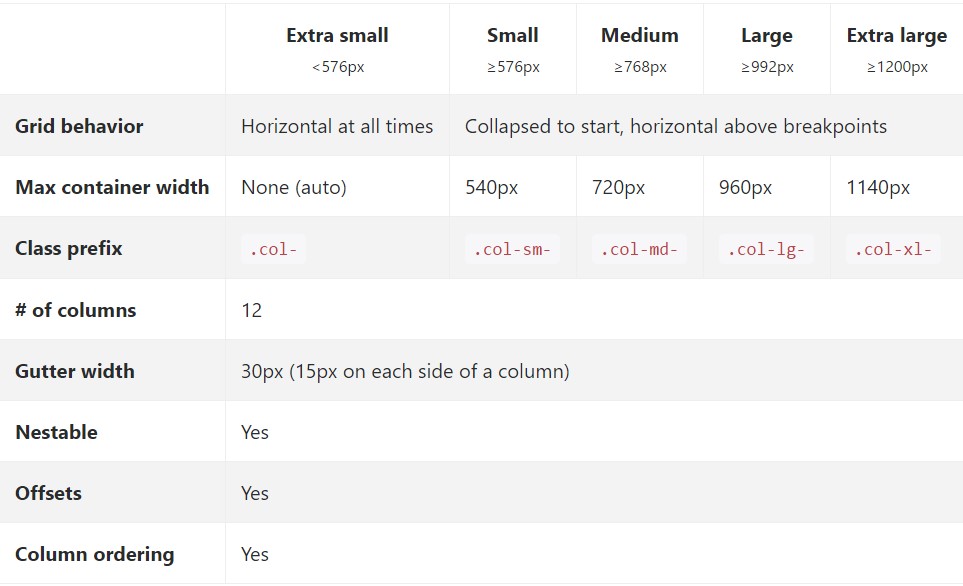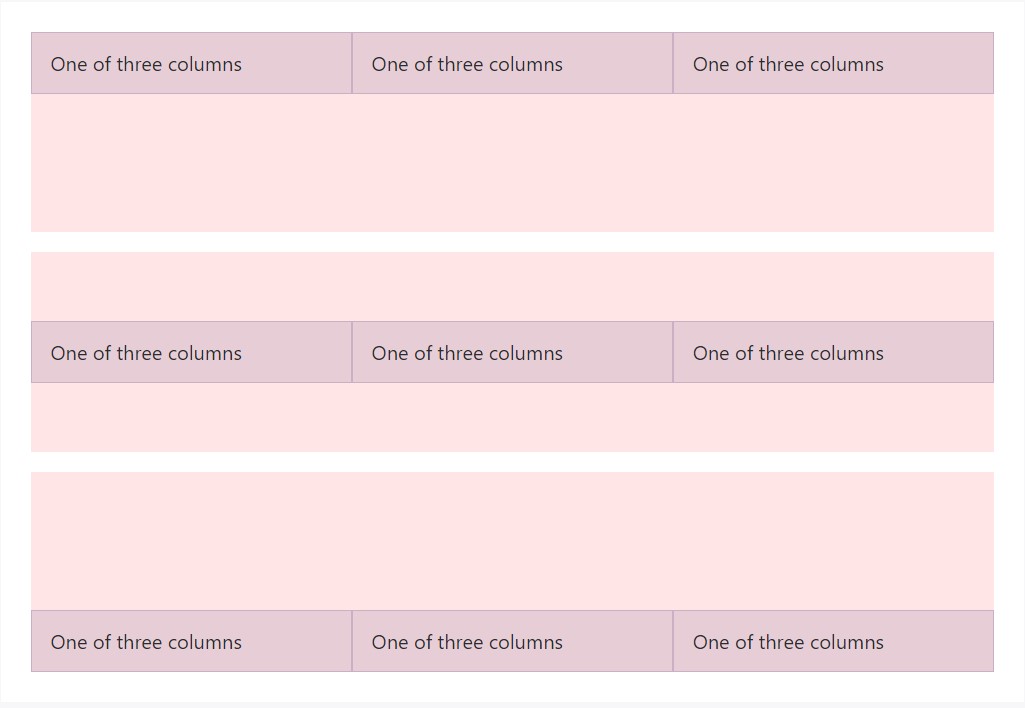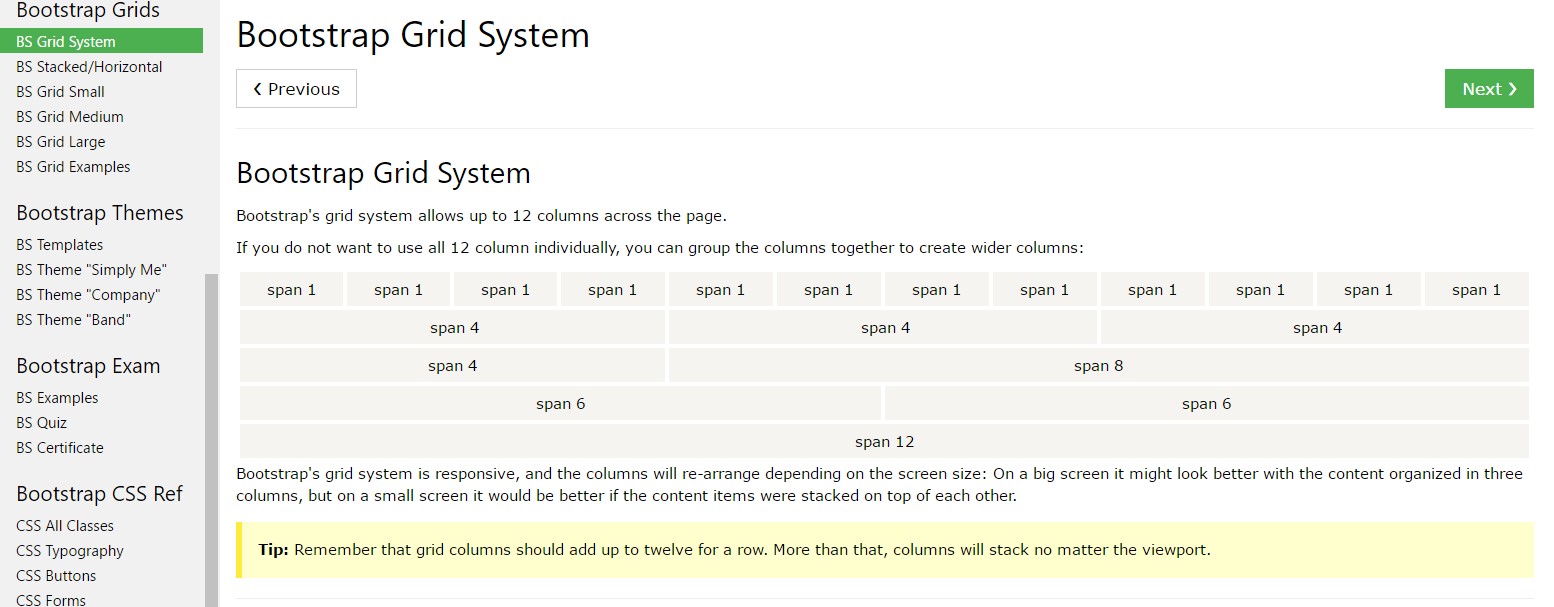Bootstrap Grid CSS
Intro
Bootstrap includes a highly effective mobile-first flexbox grid technique for designing styles of all sizes and forms . It's built on a 12 column format and has numerous tiers, one for every media query variation. You can easily use it along with Sass mixins or else of the predefined classes.
The absolute most required element of the Bootstrap platform allowing us to create responsive web pages interactively changing to constantly install the size of the screen they get featured on yet looking wonderfully is the so called grid solution. Things that it basically does is presenting us the opportunity of producing tricky formats merging row and a certain variety of column elements held inside it. Imagine that the obvious width of the screen is split up in twelve matching components vertically.
Ways to utilize the Bootstrap grid:
Bootstrap Grid Example employs a number of containers, rows, and columns to design plus fix content. It's constructed with flexbox and is entirely responsive. Listed below is an example and an in-depth examine ways the grid comes together.
The aforementioned sample makes three equal-width columns on small-sized, normal, big, and also extra big devices employing our predefined grid classes. Those columns are focused in the webpage together with the parent
.containerHere's a way it works:
- Containers present a solution to center your website's items. Apply
.container.container-fluid- Rows are horizontal sets of columns that provide your columns are actually aligned appropriately. We work with the negative margin method for
.row- Web content should really be installed within columns, also just columns may be immediate children of rows.
- Due to flexbox, grid columns without any a established width will by default format with identical widths. As an example, four instances of
.col-sm- Column classes reveal the amount of columns you 'd like to work with out of the potential 12 per row. { In such manner, on the occasion that you want three equal-width columns, you can absolutely employ
.col-sm-4- Column
widths- Columns come with horizontal
paddingmarginpadding.no-gutters.row- There are 5 grid tiers, one for every responsive breakpoint: all breakpoints (extra little), small, medium, huge, and extra large.
- Grid tiers are based on minimum widths, meaning they apply to that one tier plus all those above it (e.g.,
.col-sm-4- You are able to use predefined grid classes or Sass mixins for more semantic markup.
Take note of the limitations and also errors about flexbox, like the incapability to apply some HTML features such as flex containers.
Appears to be pretty good? Excellent, why don't we carry on to observing all that during an instance. ( more info)
Bootstrap Grid HTML capabilities
Typically the column classes are actually something like that
.col- ~ grid size-- two letters ~ - ~ width of the element in columns-- number from 1 to 12 ~.col-Whenever it approaches the Bootstrap Grid Example sizes-- all the realizable sizes of the viewport ( or else the visual space on the display) have been split up in five varies just as comes next:
Extra small-- widths under 544px or 34em ( that comes to be the default measuring unit within Bootstrap 4
.col-xs-*Small – 544px (34em) and over until 768px( 48em )
.col-sm-*Medium – 768px (48em ) and over until 992px ( 62em )
.col-md-*Large – 992px ( 62em ) and over until 1200px ( 75em )
.col-lg-*Extra large-- 1200px (75em) and everything bigger than it
.col-xl-*While Bootstrap uses
emrempxView the way in which aspects of the Bootstrap grid system do a job all around various tools along with a useful table.

The several and new from Bootstrap 3 here is one added width range-- 34em-- 48em being simply designated to the
xsAll the elements styled utilizing a specific viewport width and columns care for its overall size in width for this viewport plus all above it. Whenever the width of the display gets under the defined viewport size the features stack above each other filling the entire width of the view .
You can also appoint an offset to an element through a pointed out number of columns in a specific display screen sizing and over this is made out the classes
.offset- ~ size ~ - ~ columns ~.offset-lg-3.col- ~ size ~-offset- ~ columns ~A handful of details to take into account when designing the markup-- the grids having rows and columns ought to be positioned inside a
.container.container.container-fluidPrimary kins of the containers are the
.rowAuto format columns
Incorporate breakpoint-specific column classes for equal-width columns. Add any number of unit-less classes for each and every breakpoint you really need and each column will certainly be the identical width.
Identical size
For example, listed below are two grid designs that placed on each device and viewport, from
xs
<div class="container">
<div class="row">
<div class="col">
1 of 2
</div>
<div class="col">
1 of 2
</div>
</div>
<div class="row">
<div class="col">
1 of 3
</div>
<div class="col">
1 of 3
</div>
<div class="col">
1 of 3
</div>
</div>
</div>Placing one column size
Auto-layout for the flexbox grid columns also means you can easily put the width of one column and the others are going to quickly resize all around it. You may possibly use predefined grid classes (as shown here), grid mixins, or inline widths. Note that the other types of columns will resize despite the width of the center column.

<div class="container">
<div class="row">
<div class="col">
1 of 3
</div>
<div class="col-6">
2 of 3 (wider)
</div>
<div class="col">
3 of 3
</div>
</div>
<div class="row">
<div class="col">
1 of 3
</div>
<div class="col-5">
2 of 3 (wider)
</div>
<div class="col">
3 of 3
</div>
</div>
</div>Variable width information
Working with the
col- breakpoint -auto
<div class="container">
<div class="row justify-content-md-center">
<div class="col col-lg-2">
1 of 3
</div>
<div class="col-12 col-md-auto">
Variable width content
</div>
<div class="col col-lg-2">
3 of 3
</div>
</div>
<div class="row">
<div class="col">
1 of 3
</div>
<div class="col-12 col-md-auto">
Variable width content
</div>
<div class="col col-lg-2">
3 of 3
</div>
</div>
</div>Equal width multi-row
Set up equal-width columns which span multiple rows via inserting a
.w-100.w-100
<div class="row">
<div class="col">col</div>
<div class="col">col</div>
<div class="w-100"></div>
<div class="col">col</div>
<div class="col">col</div>
</div>Responsive classes
Bootstrap's grid provides five tiers of predefined classes to get building complex responsive formats. Custom the proportions of your columns upon extra small, small, medium, large, as well as extra large devices however you see fit.
All breakpoints
When it comes to grids that are the very same from the smallest of gadgets to the largest sized, use the
.col.col-*.col
<div class="row">
<div class="col">col</div>
<div class="col">col</div>
<div class="col">col</div>
<div class="col">col</div>
</div>
<div class="row">
<div class="col-8">col-8</div>
<div class="col-4">col-4</div>
</div>Stacked to horizontal
Making use of a singular package of
.col-sm-*
<div class="row">
<div class="col-sm-8">col-sm-8</div>
<div class="col-sm-4">col-sm-4</div>
</div>
<div class="row">
<div class="col-sm">col-sm</div>
<div class="col-sm">col-sm</div>
<div class="col-sm">col-sm</div>
</div>Mix and match
Don't wish your columns to just simply stack in several grid tiers? Utilize a combination of different classes for every tier as needed. View the example listed here for a better concept of exactly how all of it acts.

<div class="row">
<div class="col col-md-8">.col .col-md-8</div>
<div class="col-6 col-md-4">.col-6 .col-md-4</div>
</div>
<!-- Columns start at 50% wide on mobile and bump up to 33.3% wide on desktop -->
<div class="row">
<div class="col-6 col-md-4">.col-6 .col-md-4</div>
<div class="col-6 col-md-4">.col-6 .col-md-4</div>
<div class="col-6 col-md-4">.col-6 .col-md-4</div>
</div>
<!-- Columns are always 50% wide, on mobile and desktop -->
<div class="row">
<div class="col-6">.col-6</div>
<div class="col-6">.col-6</div>
</div>Alignment
Use flexbox placement utilities to vertically and horizontally straighten columns. ( learn more here)
Vertical alignment

<div class="container">
<div class="row align-items-start">
<div class="col">
One of three columns
</div>
<div class="col">
One of three columns
</div>
<div class="col">
One of three columns
</div>
</div>
<div class="row align-items-center">
<div class="col">
One of three columns
</div>
<div class="col">
One of three columns
</div>
<div class="col">
One of three columns
</div>
</div>
<div class="row align-items-end">
<div class="col">
One of three columns
</div>
<div class="col">
One of three columns
</div>
<div class="col">
One of three columns
</div>
</div>
</div>
<div class="container">
<div class="row">
<div class="col align-self-start">
One of three columns
</div>
<div class="col align-self-center">
One of three columns
</div>
<div class="col align-self-end">
One of three columns
</div>
</div>
</div>Horizontal positioning

<div class="container">
<div class="row justify-content-start">
<div class="col-4">
One of two columns
</div>
<div class="col-4">
One of two columns
</div>
</div>
<div class="row justify-content-center">
<div class="col-4">
One of two columns
</div>
<div class="col-4">
One of two columns
</div>
</div>
<div class="row justify-content-end">
<div class="col-4">
One of two columns
</div>
<div class="col-4">
One of two columns
</div>
</div>
<div class="row justify-content-around">
<div class="col-4">
One of two columns
</div>
<div class="col-4">
One of two columns
</div>
</div>
<div class="row justify-content-between">
<div class="col-4">
One of two columns
</div>
<div class="col-4">
One of two columns
</div>
</div>
</div>No gutters
The gutters around columns inside our predefined grid classes can possibly be gotten rid of with
.no-guttersmargin.rowpaddingHere is actually the origin code for making these particular formats. Take note that column overrides are scoped to just the primary children columns and are actually targeted by means of attribute selector. Even though this develops a more certain selector, column padding can still be additional customised along with space utilities.
.no-gutters
margin-right: 0;
margin-left: 0;
> .col,
> [class*="col-"]
padding-right: 0;
padding-left: 0;In practice, here's how it appears. Consider you can surely continuously work with this along with all of the various other predefined grid classes ( featuring column widths, responsive tiers, reorders, and furthermore ).

<div class="row no-gutters">
<div class="col-12 col-sm-6 col-md-8">.col-12 .col-sm-6 .col-md-8</div>
<div class="col-6 col-md-4">.col-6 .col-md-4</div>
</div>Column wrapping
On the occasion that greater than 12 columns are situated inside a single row, each set of extra columns will, as being one unit, wrap onto a new line.

<div class="row">
<div class="col-9">.col-9</div>
<div class="col-4">.col-4<br>Since 9 + 4 = 13 > 12, this 4-column-wide div gets wrapped onto a new line as one contiguous unit.</div>
<div class="col-6">.col-6<br>Subsequent columns continue along the new line.</div>
</div>Reseting of the columns
Having the selection of grid tiers accessible, you are certainly expecteded to run into troubles where, at specific breakpoints, your columns don't clear pretty appropriate being one is taller compared to the various other. To take care of that, utilize a mixture of a
.clearfix
<div class="row">
<div class="col-6 col-sm-3">.col-6 .col-sm-3</div>
<div class="col-6 col-sm-3">.col-6 .col-sm-3</div>
<!-- Add the extra clearfix for only the required viewport -->
<div class="clearfix hidden-sm-up"></div>
<div class="col-6 col-sm-3">.col-6 .col-sm-3</div>
<div class="col-6 col-sm-3">.col-6 .col-sm-3</div>
</div>Besides column clearing up at responsive breakpoints, you may perhaps have to reset offsets, pushes, or else pulls. Discover this at work in the grid good example.

<div class="row">
<div class="col-sm-5 col-md-6">.col-sm-5 .col-md-6</div>
<div class="col-sm-5 offset-sm-2 col-md-6 offset-md-0">.col-sm-5 .offset-sm-2 .col-md-6 .offset-md-0</div>
</div>
<div class="row">
<div class="col-sm-6 col-md-5 col-lg-6">.col.col-sm-6.col-md-5.col-lg-6</div>
<div class="col-sm-6 col-md-5 offset-md-2 col-lg-6 offset-lg-0">.col-sm-6 .col-md-5 .offset-md-2 .col-lg-6 .offset-lg-0</div>
</div>Re-ordering
Flex order
Employ flexbox utilities for regulating the visional ordination of your web content.

<div class="container">
<div class="row">
<div class="col flex-unordered">
First, but unordered
</div>
<div class="col flex-last">
Second, but last
</div>
<div class="col flex-first">
Third, but first
</div>
</div>
</div>Offsetting columns
Transfer columns to the right employing
.offset-md-**.offset-md-4.col-md-4
<div class="row">
<div class="col-md-4">.col-md-4</div>
<div class="col-md-4 offset-md-4">.col-md-4 .offset-md-4</div>
</div>
<div class="row">
<div class="col-md-3 offset-md-3">.col-md-3 .offset-md-3</div>
<div class="col-md-3 offset-md-3">.col-md-3 .offset-md-3</div>
</div>
<div class="row">
<div class="col-md-6 offset-md-3">.col-md-6 .offset-md-3</div>
</div>Pulling and pushing
Effectively change the structure of our incorporated grid columns along with
.push-md-*.pull-md-*
<div class="row">
<div class="col-md-9 push-md-3">.col-md-9 .push-md-3</div>
<div class="col-md-3 pull-md-9">.col-md-3 .pull-md-9</div>
</div>Information placement
To roost your material with the default grid, add a brand-new
.row.col-sm-*.col-sm-*
<div class="row">
<div class="col-sm-9">
Level 1: .col-sm-9
<div class="row">
<div class="col-8 col-sm-6">
Level 2: .col-8 .col-sm-6
</div>
<div class="col-4 col-sm-6">
Level 2: .col-4 .col-sm-6
</div>
</div>
</div>
</div>Employing Bootstrap's origin Sass information
Whenever working with Bootstrap's source Sass files, you have the option of applying Sass variables and mixins to set up customized, semantic, and responsive page formats. Our predefined grid classes apply these same variables and mixins to provide a whole collection of ready-to-use classes for quick responsive layouts .
Options
Maps and variables establish the number of columns, the gutter width, and the media query point. We work with these to develop the predefined grid classes reported above, as well as for the custom-made mixins listed below.
$grid-columns: 12;
$grid-gutter-width-base: 30px;
$grid-gutter-widths: (
xs: $grid-gutter-width-base, // 30px
sm: $grid-gutter-width-base, // 30px
md: $grid-gutter-width-base, // 30px
lg: $grid-gutter-width-base, // 30px
xl: $grid-gutter-width-base // 30px
)
$grid-breakpoints: (
// Extra small screen / phone
xs: 0,
// Small screen / phone
sm: 576px,
// Medium screen / tablet
md: 768px,
// Large screen / desktop
lg: 992px,
// Extra large screen / wide desktop
xl: 1200px
);
$container-max-widths: (
sm: 540px,
md: 720px,
lg: 960px,
xl: 1140px
);Mixins
Mixins are taken along with the grid variables to produce semantic CSS for specific grid columns.
@mixin make-row($gutters: $grid-gutter-widths)
display: flex;
flex-wrap: wrap;
@each $breakpoint in map-keys($gutters)
@include media-breakpoint-up($breakpoint)
$gutter: map-get($gutters, $breakpoint);
margin-right: ($gutter / -2);
margin-left: ($gutter / -2);
// Make the element grid-ready (applying everything but the width)
@mixin make-col-ready($gutters: $grid-gutter-widths)
position: relative;
// Prevent columns from becoming too narrow when at smaller grid tiers by
// always setting `width: 100%;`. This works because we use `flex` values
// later on to override this initial width.
width: 100%;
min-height: 1px; // Prevent collapsing
@each $breakpoint in map-keys($gutters)
@include media-breakpoint-up($breakpoint)
$gutter: map-get($gutters, $breakpoint);
padding-right: ($gutter / 2);
padding-left: ($gutter / 2);
@mixin make-col($size, $columns: $grid-columns)
flex: 0 0 percentage($size / $columns);
width: percentage($size / $columns);
// Add a `max-width` to ensure content within each column does not blow out
// the width of the column. Applies to IE10+ and Firefox. Chrome and Safari
// do not appear to require this.
max-width: percentage($size / $columns);
// Get fancy by offsetting, or changing the sort order
@mixin make-col-offset($size, $columns: $grid-columns)
margin-left: percentage($size / $columns);
@mixin make-col-push($size, $columns: $grid-columns)
left: if($size > 0, percentage($size / $columns), auto);
@mixin make-col-pull($size, $columns: $grid-columns)
right: if($size > 0, percentage($size / $columns), auto);An example usage
You can transform the variables to your very own custom-made values, or else simply use the mixins with their default values. Here is literally an instance of utilizing the default settings to produce a two-column design having a space among.
See it at work within this provided good example.
.container
max-width: 60em;
@include make-container();
.row
@include make-row();
.content-main
@include make-col-ready();
@media (max-width: 32em)
@include make-col(6);
@media (min-width: 32.1em)
@include make-col(8);
.content-secondary
@include make-col-ready();
@media (max-width: 32em)
@include make-col(6);
@media (min-width: 32.1em)
@include make-col(4);<div class="container">
<div class="row">
<div class="content-main">...</div>
<div class="content-secondary">...</div>
</div>
</div>Customizing the grid
Utilizing our embedded grid Sass variables and maps , it is certainly attainable to fully modify the predefined grid classes. Shift the quantity of tiers, the media query dimensions, and also the container widths-- then recompile.
Columns and gutters
The amount of grid columns and also their horizontal padding (aka, gutters) can possibly be modified via Sass variables.
$grid-columns$grid-gutter-widthspadding-leftpadding-right$grid-columns: 12 !default;
$grid-gutter-width-base: 30px !default;
$grid-gutter-widths: (
xs: $grid-gutter-width-base,
sm: $grid-gutter-width-base,
md: $grid-gutter-width-base,
lg: $grid-gutter-width-base,
xl: $grid-gutter-width-base
) !default;Capabilities of grids
Moving further the columns themselves, you may in addition customize the variety of grid tiers. In the case that you required simply three grid tiers, you would certainly modify the
$ grid-breakpoints$ container-max-widths$grid-breakpoints: (
sm: 480px,
md: 768px,
lg: 1024px
);
$container-max-widths: (
sm: 420px,
md: 720px,
lg: 960px
);If making any type of changes to the Sass maps or variables , you'll have to save your updates and recompile. Doing this will out a brand new group of predefined grid classes for column widths, offsets, pushes, and pulls. Responsive visibility utilities will additionally be upgraded to employ the custom-made breakpoints.
Final thoughts
These are truly the undeveloped column grids in the framework. Operating certain classes we can certainly direct the special features to span a determined amount of columns baseding on the real width in pixels of the viewable area where the webpage gets presented. And considering there are simply a plenty of classes specifying the column width of the items rather than looking at everyone it's more effective to try to learn about the way they actually get constructed-- it is undoubtedly very simple to remember featuring simply a couple of things in mind.
Check some on-line video training regarding Bootstrap grid
Linked topics:
Bootstrap grid formal information

W3schools:Bootstrap grid training

Bootstrap Grid column

